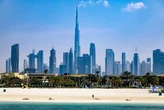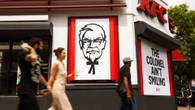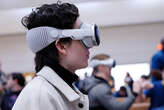Art has long been seen as a mirror to society’s darker realities—and so far, the works artists and designers have released following former President Donald Trump’s election victory last Tuesday reflect a jumble of sadness, fear, disillusionment, and hints of resilience.
Shepard Fairey, who was heavily involved in campaigns to support voter engagement, has depicted democracy in a literal coffin. Artist and illustrator Oliver Jeffers shared a painting of turbulent waves with the words “LOST AT SEA” painted over them. Even the Banksy archive resurfaced a poignant old mural in which the artist stamped the word “CANCELLED” over the words “FOLLOW YOUR DREAMS.”
View this post on Instagram A post shared by Shepard Fairey (@obeygiant)
View this post on Instagram
A post shared by Shepard Fairey (@obeygiant)
For many, Trump’s win came as a surprise. Françoise Mouly, The New Yorker’s longtime art editor, simply couldn’t imagine a Trump win, and had prepared a cover image called “Madame President.”
“A lot of what I do is . . . talk to artists, look at sketches, and see what feels right in terms of capturing the feeling of the moment,” Mouly said. “Last week, it was a failure of the imagination to imagine an overwhelming victory for Trump.” Mouly, with cartoonist and illustrator Barry Blitt, ultimately developed a striking ink-blot silhouette of Trump in under an hour (it will appear on this week’s New Yorker cover). Jessica Walsh, an art director and illustrator whose work often touches on mental health and women’s rights, also had an Instagram post ready to celebrate Kamala Harris’s victory. Then she woke up to the news and “all those feelings rushed in,” she says.
Here, we survey how artists have captured, as Mouly says, “the feeling of the moment” so far.
View this post on Instagram A post shared by Jessica Walsh (@jessicavwalsh)
A post shared by Jessica Walsh (@jessicavwalsh)
2016 all over again
For many people in the creative industry, Trump’s win last week felt just as surreal as his win eight years ago—if not even more so. Designer Debbie Millman reposted an image of a T-chart depicting words of grief for today and words of hope for tomorrow. “Made this the morning after the 2016 election and can’t believe I have to bring it out again,” she wrote in her caption.
Walsh resurfaced images she had previously made when feeling exhausted, burned out, or like she’d lost her mind. “Some were probably even from Trump’s last presidency,” she says. One of them shows a toaster imprinted with the words “BURNT OUT” holding two slices of burning toast. Another depicts a tear-off flyer with the words “LOST my MIND, IF FOUND, PLEASE CALL 1-800-LOST-AF.”
Jeffers’s “LOST AT SEA” painting was also a replay of Trump’s 2016 win. “I don’t feel like creating [new work] right now, but I hope this too passes,” he told me. Jeffers had been making that painting around the election eight years ago, and added the words the day after Trump won. “I felt like a rudderless boat in a turbulent sea,” he says. When Trump won again, the painting felt painfully relevant.
View this post on Instagram A post shared by Oliver Jeffers (@oliverjeffers)
A post shared by Oliver Jeffers (@oliverjeffers)
Fairey’s “democracy in a coffin” image is also from 2016, but with a slight, yet crucial, tweak. In the old version, Fairey had put “DIGNITY” on the coffin. Now he’s changed it to “DEMOCRACY,” he says, because “our entire democratic system could be dismantled under Trump, and a lot of people don’t seem to care or would rather debate whether COVID-spurred inflation was Trump’s fault or Biden-Harris’s fault.”
That these artists chose to resurface or adapt old work instead of create something new betrays a certain level of paralysis that many of us felt in the aftermath of the election. It also shows that the very idea behind Harris’s “New Way Forward” campaign didn’t come to fruition. We are not going forward. We are going backward.
Resignation and resolve
Some might find it unproductive to dwell on the doom and gloom, but for many of the artists interviewed for this story, there is value in sitting with all of these feelings and capturing the mood of this moment before creating calls for action. “It reminds people they’re not alone,” Jeffers says.
“I think there’s a place for artists to sit with discomfort, to capture the unfiltered emotions of our time, even if they feel bleak,” Walsh says.
Every artist has different methods of coping. Fairey, who created Barack Obama’s famous “Hope” poster as well as Harris’s “Forward” campaign, is adamant that the only value in the doom and gloom is if it serves as a “wake-up call.” Because “apathy lets the rust of bad ideas creep even further,” he says.
View this post on Instagram A post shared by Ji Lee / 이지별 / personal projects (@jileecious)
A post shared by Ji Lee / 이지별 / personal projects (@jileecious)
Ji Lee, an artist, illustrator, and executive VP of Samsung, used dark humor as a visual communication tool. The day after Trump’s election, he posted an image of a medicinal vial with a label that reads “4 YEARS HIBERNATION,” noting, “In difficult moments like this, I feel the urge to express my outrage,” he says. “But I don’t want to just rant and vent on my social media echo chamber. Instead, I like using humor as a commentary on an outrageous event.”
Meanwhile, Till Lauer, a visual artist whose work has appeared in The Economist, The Guardian, and The New Yorker, utilized more optimism, even if mixed with sadness. Two days after the election news broke, he posted a GIF of a flower that looks healthy, then suddenly droops, crying tears that water the soil below.
View this post on Instagram A post shared by Till Lauer (@till_lauer)
A post shared by Till Lauer (@till_lauer)
“On the one hand, I felt a great sense of sadness and fear in the face of the dangers posed by the election results,” he says. “At the same time, I also felt an unexpected surge of energy and hope, and a strong will to connect, organize, and fight for my values. If we understand the world as cyclical, today’s tears might well foster tomorrow’s growth.”








No comments